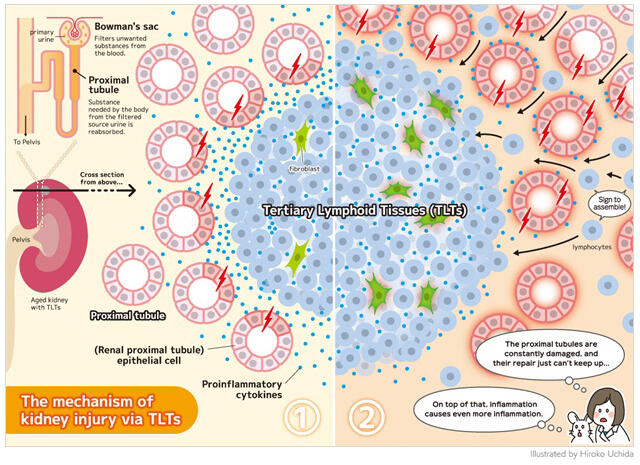Approximately 10% of the world's population is affected by chronic kidney disease, which involves declining kidney function. In cases of acute kidney disorder, kidney function tends to recover in young people but worsen in older persons. The formation of inflammatory lesions in kidney disease that are similar to lymph nodes—called tertiary lymphoid structures (TLTs)—reportedly leads to poor prognosis and chronic kidney disease by a currently unknown mechanism.
A research group led by Professor Motoko Yanagita and Assistant Professor Takahisa Yoshikawa of the Graduate School of Medicine at Kyoto University has revealed the mechanism by which TLTs expand to damage the kidneys. The TLT of the kidneys directly impairs the surrounding proximal tubular epithelial cells, and the damaged proximal tubules and renal parenchymal cells (fibroblasts) interact with blood cells to expand the TLT. The findings of this research are expected to lead to the development of new treatment methods. This achievement was published online in the Journal of the American Society of Nephrology.

Provided by Kyoto University, ©Hiroko Uchida
The research group conducted single-cell gene expression analyses of the kidneys of elderly mice in which TLTs had formed. As a result, blood cells, especially lymphocytes within the TLT, overproduced the inflammatory cytokines tumor-necrosis factor-α and interferon-γ, which were then transmitted to the surrounding proximal tubules to cause irreversible damage. The research group also revealed that the fibroblasts in the tubules and TLTs proximal to this damage assumed inflammatory properties upon cytokine exposure. Through this, they identified the mechanism of TLT expansion, and that inflammation worsened upon attracting blood cells.
Furthermore, the researchers confirmed that the TLTs present in human transplanted kidney tissue are surrounded by inflammatory damaged proximal tubules and contain inflammatory fibroblasts. This suggested that cell-to-cell interactions occurred in humans similar to those in mice.
Yoshikawa stated, "TLTs are lesions that are observed in chronic kidney disease of elderly men as well as in various kidney diseases, and the understanding of the mechanism of kidney damage by TLTs may contribute to the development of cross-disciplinary treatments for kidney disease. Based on the analytical results we obtained to date and expect to see in the future, we will develop new therapeutic drugs for chronic kidney disease and save the lives of patients who require dialysis or kidney transplantation due to its progression. I plan to devote my life to research to help these patients."
Journal Information
Publication: Journal of the American Society of Nephrology
Title: Tertiary Lymphoid Tissues Are Microenvironments with Intensive Interactions between Immune Cells and Proinflammatory Parenchymal Cells in Aged Kidneys
DOI: 10.1681/ASN.0000000000000202
This article has been translated by JST with permission from The Science News Ltd. (https://sci-news.co.jp/). Unauthorized reproduction of the article and photographs is prohibited.




